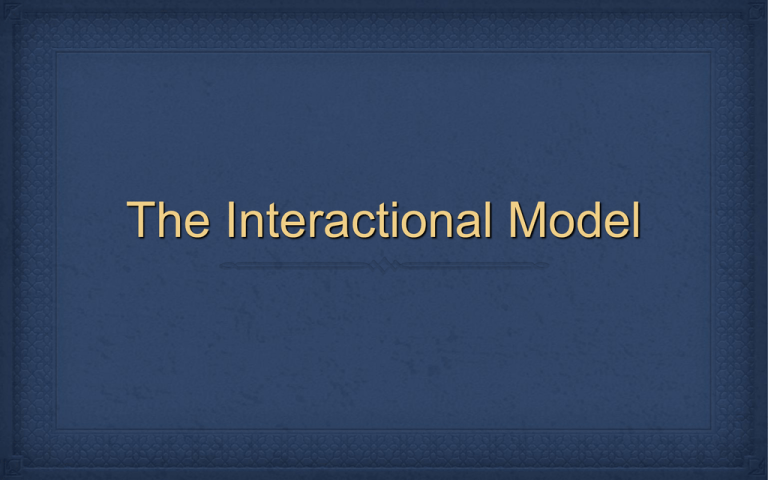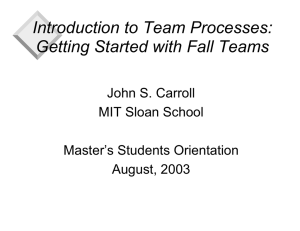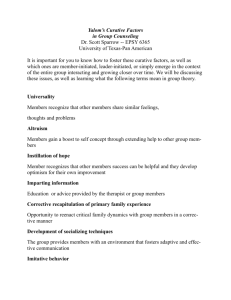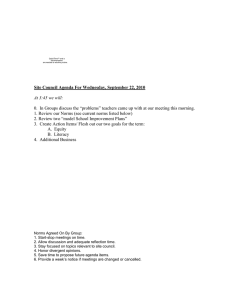The Interactional Model
advertisement

The Interactional Model Model Adopted from Yalom Arose out of Harry Stack Sullivan’s Interpersonal Psychiatry Jerome Frank’s Work (Psychiatrist / Psychotherapist) Yalom’s Basic Tasks Ensure the physical survival of the group Build a group culture and establish therapeutic norms Teach and model for the group members in the here and now work in the group setting Building a Group Culture: Establishing Group Norms Crucial to the Interactional model is the creating an atmosphere where group members feel free to comment on the immediate feelings they experience toward each member and toward the leader(s) in the group Six Essential Norms 1. Honest and Spontaneity encouraged and sanctioned 2. Ensure high level of involvement from all participants 3. Self-disclosure model (reciprocal vulnerability) 4. Establishing nonjudgemental acceptance of other group members’ shortcomings, personal failings 5. Instillation in every group member of the desire for selfunderstanding 6. Recognition of dis-satisfaction with self experienced desire to change dissatisfaction and behavior related to encouraged Development of these Norms Predispose... Group members discard social norms that they have been conditioned by Try new behavior and take risks with there interactions with other group members Mirroring Interpersonal Honesty and Spontaneity “Honesty with bad intentions is worse than a lie” Timing of interpretations (making safe to disclose and tell secrets) “holy insecurity and the narrow ridge” (no absolute knowledge) Establishment of Group Norms: Critical Questions and Meta-disclosures (cont). Questions for evaluation and reflection 1. I see a half hour has gone by and how has the group done today? 2. Is each of you satisfied with its direction and content? If not, why haven’t you said anything? 3. What could you have done differently? 4. What stopped you from taking action? 5. How would you rate group on a scale between 1 and 10 - how would you rate yourself? Big Secrets and Metadisclosures Group’s big secrets (when and how to handle these)... Group goes only as far and as deep as its most guarded member Not forced confessional Meta-disclosures (talking around big secrets, working up to them) For example, tell what is so scary if you reveal? Who might you be worried about? What do you think you might feel? Who do you think might judge you? What is the worst thing that might happen if you shared? Norm of Self-Disclosure No dirty fighting Encourage group members to share about their own reactions to conflict between members and developing coalitions or reactions to distant members In all we are trying all to be real with ourselves and with others in the group and change or act differently that our primary attachment group from the past Loved and accepted for who we are instead of trying to act a particular way to be loved, feel part of, accepted, and in turn love ourselves I am worth something if I am real! Here and Now Activation and Process Illumination Process and Intrapsyhic Focus Group leader ensures group members focus their attention on their immediate feelings and thoughts toward the other group members, the group leader, and the group as a whole. Immediate events in the group take precedence over the events in the past or current life of each member outside the group Here and now events primary for group leader We must remember though that events outside group can shape present behavior, feelings, and thoughts Getting Inside Social Macrocosm Individuals behavior outside will mirror inside - this is what we are trying to change Achilles heel of each individual group member will emerge in the here and now process Here and now requires us to examine: 1) content (current feelings of group members, and 2) process (reflective examination of what has occurred sequentially) The Content Experience of events understood, felt, and realized by all group members Paying attentional to behavioral domain, cognitive, emotional, spiritual, etc. How the individual understands themselves, while paying attention to how each individual interprets and understands events - are we seeing the same thing! Process: The Big-gee... No Not Boogey Group taught and guided to reflect back on itself and understand it’s own transactions For instance, examine reasons Joe responded to Mary and not to Bill at this particular time in this particular manner. Why does Barbie pick only men to respond to and does not respond to members in the group who might be most helpful Why does Sharon make a broad, general statement such as “I trust everyone” at a time when Sandra is talking about her fears of being judged? Here and Now Techniques Watch that not to much time is spent on there and then allow there and then, but shift theme of there and then into the here and now with members Continually think about - the why of the question, why now, what is the question really about, how is about an unconscious projection into the here and now. Parallels and unconscious repression - uncoded disguises IM’s Model Behavior Change: Six Points 1. Members must recognize what they are doing with other people 2. Then, they must appreciate the impact of their behavior on others 3. They must, in turn, understand how their behavior influences others’ opinions of them 4. Eventually they must decide if their are satisfied with this interpersonal style 5. If they decide to change, they must exercise their will to change 6. The group and the leader must help members solidify this change and generalize to the outside Change in Depth: Yalom’s 4 Ultimate Concerns Responsibility: Only I Change the World I Have Created For Myself Each person is born anew in the group Clean slate Each group member shapes his or her space and destiny in the group The group affords and allows learning, growing, risk-taking, adoption of new behaviors group members will eventually realize that is not because they cannot change they continue to suffer... It is because they will not change! Death: There is no Danger in Change Failure to transform death anxiety (root of pathology) Fear that one may fail You behave as though some danger will befall you if you attempt to change Group leader’s task detoxify fear in self to change, fear and anxieties about transforming self and attachment to current self Anxiety cements rigidity Examine fantasy of calamity Isolation - To Attain What I Really Want, I Must Change Understand payoff attain from continuing to engage in behavior that is counter to best interests What goal is being satisfied currently What is the underlying fear of change We have counter goals in our psyche both cannot be achieved (be in committed relationship vs. need to be nurtured and cradled) What needs are no longer useful as adult - where is group member developmentally? Meaninglessness - I can Change; I am Potent Rutan (1983) was quoted as saying: “As group leaders, we must not lose sight of the fact that what we see as therapist’s is a child’s normal and even at times creative adaptation to a maladaptive situation. Give them an experience Help clients realize that are potent, help them take risks, help understand true context of behavior - for which for the most part our clients we forced to make decisions on how to survive based on erroneous info usually before they were consciously able to understand there cognitions and emotions Even after these positions change - their behavior continues Watch for I can’t, I’ll try, I need, if only, I don’t




